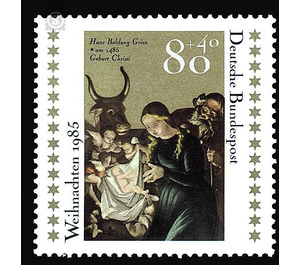Christmas; 500th birthday of Hans Baldung - Germany / Federal Republic of Germany 1985 - 80 Pfennig
| Country | Germany / Federal Republic of Germany |
| Issue Date | 1985 |
| Face Value | 80.00 |
| Color | brown |
| Perforation | K 13 3/4 |
| Printing Type | 5-color offset |
| Stamp Type | Postage stamp |
| Item Type | Stamp |
| Chronological Issue Number | 1140 |
| Chronological Chapter | GER-BRD |
| SID | 924619 |
| In 43 Wishlists | |
500 years ago - the birth date is the end of the year 1484 or the beginning of 1485 - was born, probably in Schwäbisch Gmünd in Württemberg, the painter and graphic artist Hans Baldung, called Grien. Alongside Hans Holbein, Lucas Cranach and Matthias Grünewald, he is one of the great painters of the Reformation age, which is so rich in creative personalities. With his contemporaries, predecessors and descendants usually in abundant existing documents, letters, statements from friends, inscriptions, testimonials, descriptions and comments on their own works, there are not in Hans Baldung Grien, so that almost every phase of his biography with the additions "probably "," Probably "must begin or end. Baldung came from a humanistically educated family and not like most of his colleagues from craftsmen masters or artists. The father - nothing is known about the mother - moved soon after Hans's birth with him and the older brother Kaspar to Strasbourg. Presumably he had received a call to serve the bishop of the city. Hans Baldung spends his youth in Strasbourg, the cheerful and cosmopolitan city. When his father sends him to the painter's apprenticeship, Strasbourg is home to many famous artists. Which master workshop takes him in 1498, is not known. But his master is standing, as proved by his earliest drawings, in the tradition of Martin Schongauer, this important painter and engraver of late Gothic. Around 1502 Baldungs training is completed. When he then sets out on a journey, that is a tradition at that time, he has only one goal: Albrecht Dürer, the greatest of his time, in Nuremberg. In Dürer's workshop, he probably gets the nickname Grien. It is the Old German form for "green" and probably means the peculiar background on many of his paintings. Baldung occupies a special position in Dürer's workshop. When Dürer traveled to Venice in 1505, he transferred the management of his workshop to him. Baldung Grien leaves Nuremberg before 1507, paints two altars in Halle, settles in Strasbourg after short travels, and founds his workshop there. 1512 to 1516 he receives the order to create the high altar of the Freiburg Minster with a Coronation of the Virgin as a middle image; according to his designs, the glass windows in the church are also created. Hans Baldung Grien died in 1545 in Strasbourg. Hans Baldung Grien has learned and developed much from his teacher Dürer: the portrait, the correct drawing of the human body and the use of light for the spatial effect, as the "Nativity" from the high altar of Freiburg shows especially clearly. Baldung no longer treats the religious subjects and sanctuary matters with seriousness like Dürer and Grünewald; the conception is more secular. Even in his last paintings, the "Seven Life Stages," this humanistic influence comes into its own. On the other hand, Baldung was also strongly influenced by late gothic with its allegiance to allegory, to magic and to witch and demon beings. This is shown by the fascinating motifs of the Hexensabbath. Baldung drew - on drawings and woodcuts - in grandiose compositions seductive and repulsive female bodies, while they drive their diabolical work: the witches flight, as weather witches, at the dedication to the covenant. He associated allegories of vanity, waste, and avarice with scenes of "death dance". Baldung Grien made friends with humanists and reformers, got commissions from the highest circles and enjoyed prestige and fame during his lifetime. The great historian Beatus Rhenanus wrote in 1526: "Among the most famous are Albrecht Dürer in Nuremberg, Johannes Baldung in Strasbourg, Lucas Cranach in Saxony, Johannes Holbein in Augsburg ..."


